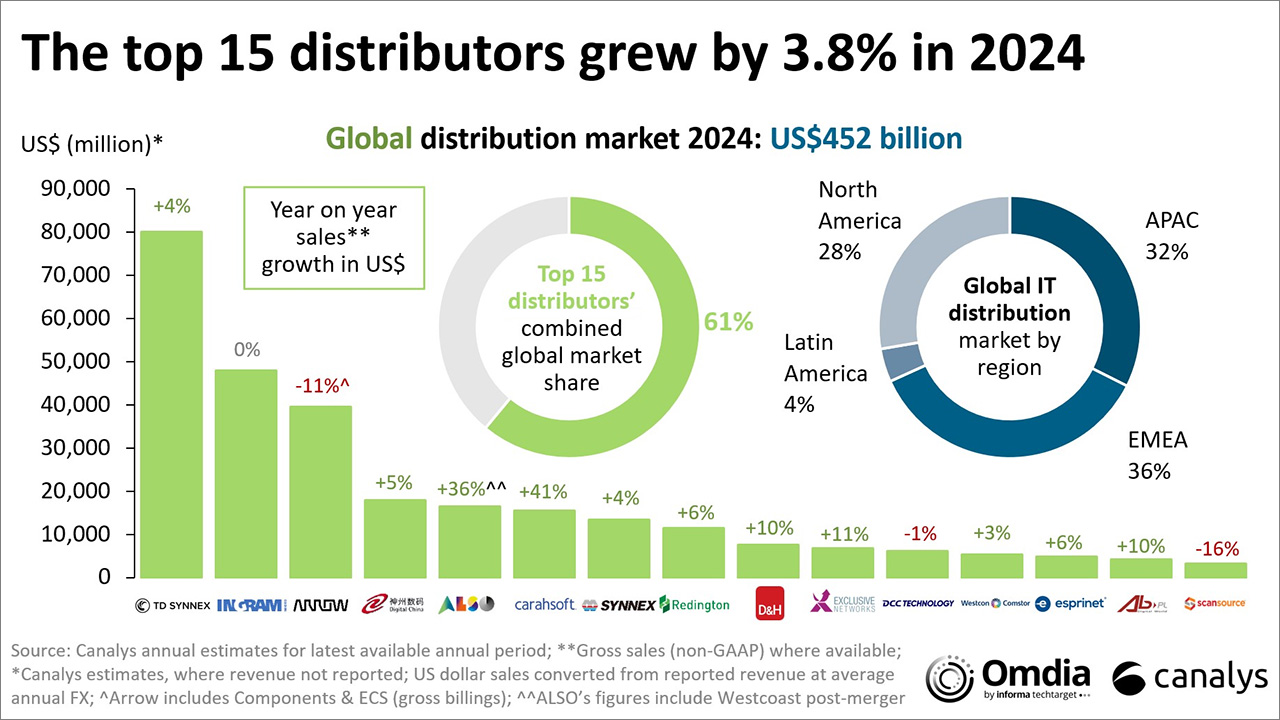Expanded Scale and Leadership in B2B: From R&D to ROI
With a combined permissioned audience of 50+ million professionals, TechTarget and Informa Tech’s digital businesses have come together to offer industry-leading, global solutions that enable vendors in enterprise technology and other key industry markets to accelerate their revenue growth at scale.

Navigating IT spending shifts: 7% growth forecast with partner-delivered IT to account for 70%
Canalys’ (now part of Omdia) May IT Opportunity update predicts a 7.0% growth in worldwide IT spending in 2025, reaching US$5.35 trillion. While this is lower than the previous forecast of 8.3%, it remains above the long-term average of 5.4% between 2016 and 2024, despite current macroeconomic and geopolitical uncertainties. The market is undergoing profound shifts due to investments in AI and expanding partner ecosystems.

The global IT market is undergoing profound shifts as economic volatility, geopolitics and changing alliances, the unleashing of AI, and expanding partner ecosystems shape the industry’s trajectory. According to the latest Canalys (part of Omdia) analysis, total IT spending is expected to reach US$5.35 trillion in 2025, reflecting 7.0% annual growth. While this represents a downward revision from the previous forecast of 8.3% made in November 2024, the tech industry continues to demonstrate resilience, with IT infrastructure, cybersecurity, cloud infrastructure services, cloud application software and managed IT services creating growth opportunities for vendors and partners.
The global GDP growth rate forecast for 2025 was downgraded to 2.2%, reflecting the current macroeconomic and geopolitical uncertainties. Although US trade tariffs were anticipated, their swift implementation, broad scope, including the 10% universal levy and tariffs of up to 50% on major surplus partners, along with unpredictable timing and escalating tensions with China, were not. The 90-day tariff pause and ongoing trade negotiations have helped ease some concerns, yet uncertainty remains high, with the risk of widespread disruption still looming. Despite these challenges, IT spending and GDP growth will continue to diverge, driven by strong demand drivers and sustained investment in key areas.
Unleashing of AI starts a multi-year investment super cycle
IT spending over the next five years will prioritize enabling, embedding and operationalizing AI to transform user experiences, customer interactions, and business processes.
Initial investments have centered on data center expansion and upgrades to meet the rising demand for high-performance computing for AI training and inference. In 2025, total data center CAPEX is projected to grow by 25.8% to US$598 billion, with servers (+33.5%) accounting for 51% of total investment. This upward trend is expected to continue, with data center CAPEX approaching US$1 trillion by 2030, reinforcing AI’s central role in shaping future technology ecosystems. Network investment will return to growth (+7.4%) this year, though at a lower rate than previously forecast. Normalization of orders as well as data center switching, especially 400G and 800G for back-end networks of AI clusters, and the start of upgrades to front-end networks for AI and Wi-Fi 7 refresh cycle in campus environments, will be catalysts for growth.
Customer investment in the hyperscalers’ AI offerings, combined with organizations refocusing on infrastructure modernization, will continue the robust growth of cloud infrastructure services (+23.9%) use in 2025. This follows the attenuation of cost optimization initiatives in 2023 and early 2024.
Partner sentiment weakens but growth opportunities remain
Economic uncertainty, compounded by trade disruptions and potential supply chain issues, presents significant challenges for channel partners this year. Successfully navigating these complexities will demand agility and strategic planning. In response to tariff announcements and mounting concerns over an economic slowdown, partners’ revenue growth and profitability expectations declined in the first quarter of the year, reflecting apprehension about its impact on customer IT spending. However, most partners anticipate growth in 2025. Canalys (now part of Omdia) forecasts partner-delivered IT to grow 5.5% this year. This marks an improvement over 2024 and the low single-digit growth rates of 2022 and 2023, though still below previous forecasts.
Key hardware categories will increase for partners in 2025, including client computing, networking, firewall appliances and servers. But these will remain cyclical, driven by installed base refresh. However, cybersecurity, managed IT services and cloud application software will sustain growth over the long-term for partners:
- Cybersecurity technology will remain a key priority for organizations as they contend with persistent threats, with projected growth of 9.1% this year. However, budgets will be closely scrutinized. Priority areas include SIEM transformation, identity and cloud security, risk management and AI-driven solutions. Over 90% of cybersecurity spend will be via partners.
- Managed IT services will outpace IT spending, expanding 12.6% to surpass US$600 billion. AI-driven automation and optimization, alongside demand for cybersecurity offerings such as MDR and compliance for cyber-insurance, will fuel sustained growth for partners. The need for multi- and hybrid-cloud management will drive additional growth.
- Cloud application software will grow 22.3% in 2025, fueling growth for partners migrating customers from on-premises software deployments to cloud-based SaaS services. The emergence of agentic AI further amplifies opportunities. As organizations prioritize AI-enhanced SaaS models, partners can capitalize on evolving market dynamics by offering strategic implementation and optimization services.
Despite their share of the total addressable market declining to 70% in 2025, partners will continue to influence IT spending in every region and across each technology and service category. While they missed the initial AI boom tied to data center infrastructure buildouts, the next phase of investment, focused on edge, secure AI adoption and business transformation, will unlock new growth opportunities over the next five years. In response, vendors will scale investments in partner programs, enhancing skills, capabilities and capacity to ensure partners can effectively deliver in this next era of the tech industry.







